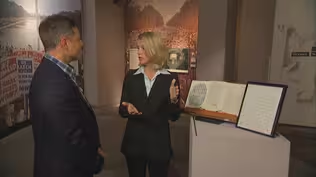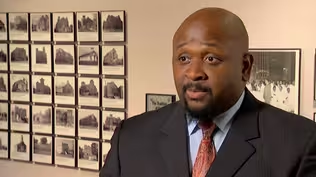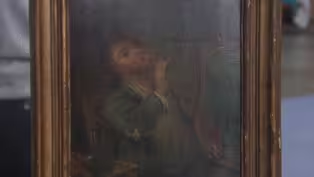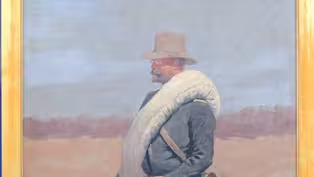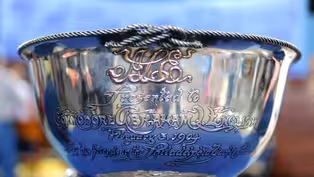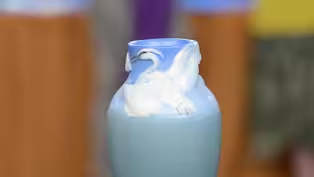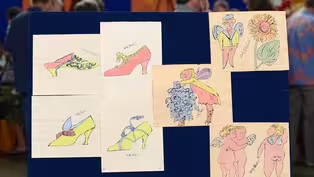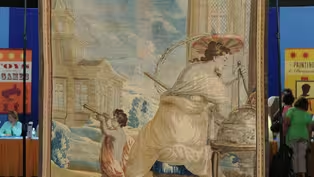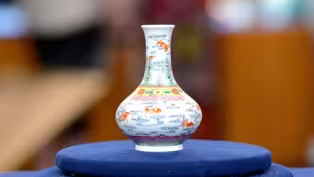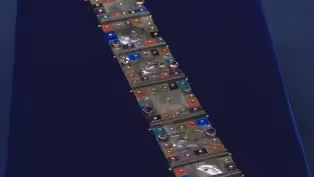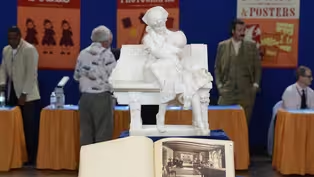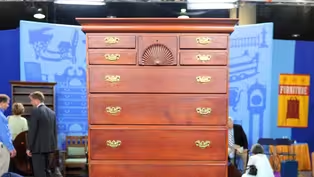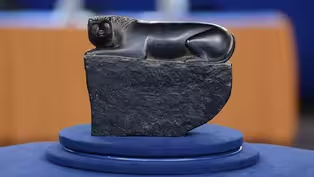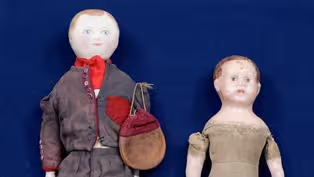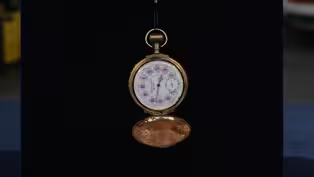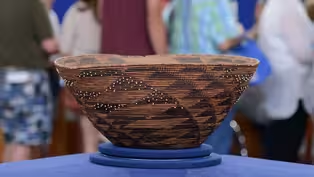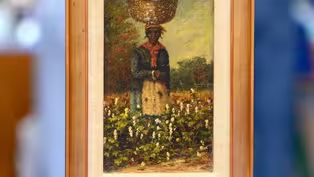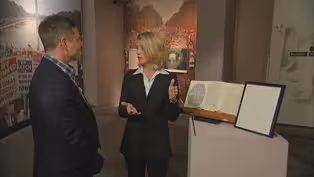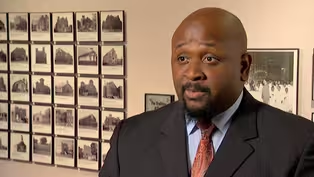
Birmingham, Hour 1 (2015)
Season 19 Episode 10 | 52m 59sVideo has Closed Captions
ROADSHOW stops in Birmingham and visits the Birmingham Civil Rights Institute.
ANTIQUES ROADSHOW stops in Birmingham, where host Mark L. Walberg joins appraiser Catherine Williamson at the Birmingham Civil Rights Institute to discuss the Civil Rights Movement of the mid-20th century and to look at materials related to Rev. Martin Luther King, Jr.
Problems playing video? | Closed Captioning Feedback
Problems playing video? | Closed Captioning Feedback
Funding for ANTIQUES ROADSHOW is provided by Ancestry and American Cruise Lines. Additional funding is provided by public television viewers.

Birmingham, Hour 1 (2015)
Season 19 Episode 10 | 52m 59sVideo has Closed Captions
ANTIQUES ROADSHOW stops in Birmingham, where host Mark L. Walberg joins appraiser Catherine Williamson at the Birmingham Civil Rights Institute to discuss the Civil Rights Movement of the mid-20th century and to look at materials related to Rev. Martin Luther King, Jr.
Problems playing video? | Closed Captioning Feedback
How to Watch Antiques Roadshow
Antiques Roadshow is available to stream on pbs.org and the free PBS App, available on iPhone, Apple TV, Android TV, Android smartphones, Amazon Fire TV, Amazon Fire Tablet, Roku, Samsung Smart TV, and Vizio.
Buy Now
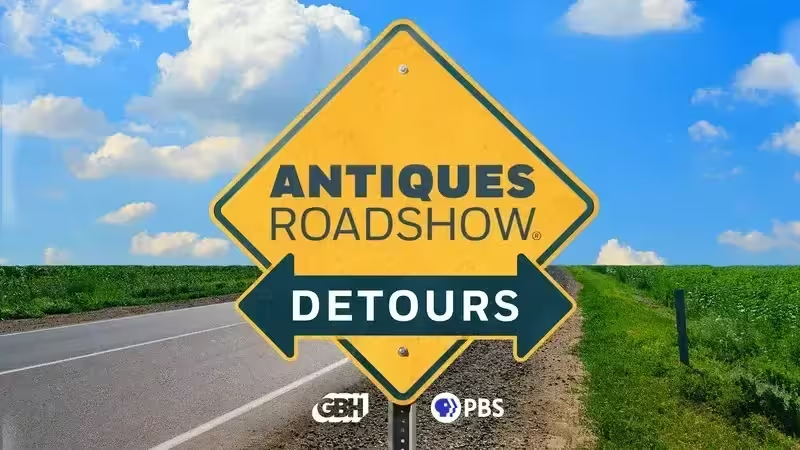
ANTIQUES ROADSHOW DETOURS
Ever wondered what happens to the treasures featured on America’s beloved ANTIQUES ROADSHOW after the cameras leave town? Host Adam Monahan tracks down the juicy afterlives of your favorite finds from PBS’s hit series.Providing Support for PBS.org
Learn Moreabout PBS online sponsorshipFrom Birmingham, Alabama, it's Antiques Roadshow.
I've never reprimanded a guest for manhandling a painting before.
I'm glad you're taking care of my painting.
I played with it all the time in the dirt.
I never played with my other dolls.
They were pretty and nice.
Whoa.
That is amazing.
Treasures from the Magic City are in the limelight right now.
Welcome to Antiques Roadshow.
Hi, I'm Mark Walberg in Birmingham, Alabama.
Alabama has been called the Yellow Hammer State since the Civil War, inspired by Alabama soldiers who had uniforms with yellow trim.
Their eye-catching look was likened to what is now the state bird, the Yellow Hammer, or Northern Flicker Woodpecker.
People have flocked to Birmingham today with their treasures, and several have gotten the attention of our appraisers.
Check it out.
This is a dear old friend.
He's 63 years old.
His name is Dynamite.
Say hi, Dynamite.
Well, a little arthritis, maybe, like me.
I got him as my bear in 1951.
My dad got him for me because my dog had to go to stay with my grandmother in West Virginia because we were moving to Chicago.
He's been with me ever since, all these years.
All those years.
Yeah, he used to be 35 inches... 36, but I measured him today, and now he's only 35, so I think he's got a little osteoporosis, too.
I guess so.
I see here we have a picture of you back in 1951.
Yeah, with my mom there.
It always amazes me when somebody carries it around all through their life.
And obviously you took care of it because he's really, really in good shape.
It's so seldom that this stays so soft.
Well, I've kept him in a box.
Oh, there you go.
Sealed up.
As I said he's in great condition, but I do notice somewhere that somebody's done a little artistic work down here on his feet.
Well, yeah.
I think that was probably my daughter and maybe my cousins.
He's had a lot of loving from a lot of other folks, too, along the line.
Of course, this bear was made by Steiff, and they were the premier maker of toy bears.
They started in business in the 1880s and just made regular little different kinds of animal toys.
And it wasn't until around 1903 that they made their first bear.
By 1907, they were making 950,000 bears a year.
Whoa.
And it wasn't until shortly after they were brought over into this country, which was right after the first introduction at a toy fair in Europe, that an enterprising toy shop owner heard about Teddy Roosevelt going off on a bear hunt in which there were some difficulties involved, and he said, "Well, let's call this bear a teddy bear."
And that's why they're teddy bears, and that helped spur the incredible popularity.
Of course, everybody who watches this show knows we look for a button in the ear.
In this case, he didn't have a button.
He had this little bear symbol on his collar, and it's surprising you still have it.
Now, the bears that are really, really valuable are those ones from that very first era, right after 1903 into '07, and some into the early '20s.
They can bring astronomical prices.
If you were to put it in auction, which I doubt seriously you would, I think this guy would do well over the $100 your father paid for it.
I think a fair auction price today would be about $3,500.
Oh, you're kidding.
Wow.
Dynamite, you hear that?
$3,500.
Wow, that's a dynamite price.
MAN: I'm pretty sure that my father collected it while he was working out West when he was in college.
My father became an anthropologist archaeologist and founded the anthropology department of Florida State University.
We would travel... like, when I was 12, we went to Panama and stayed with the Choco Indians up the Chagres River.
And stuff that was laying around, it was just... they were just there.
It was like things in the house.
He passed away too soon for me to really understand everything that he had.
I've had this in my house for 25 years.
And how do you display it?
This has just been actually in a closet because the way the beadwork is loose, it would get torn up by our two children.
All right.
Well, it's an extraordinary basket made by the Pomo of Northern California, and the Pomo Indians are known for their basketry excellence.
A large basket like this was a sign of someone being very prosperous.
This basket was probably made about 1850 to 1875.
Oh, really?
And it was probably made for native use and not for sale.
Baskets like this would be used for life passage situations: births, dowries, to pay a debt.
This was a gift basket.
It has gift basket attributes, where you have the beads attached to it.
It's absolutely beautifully woven.
If you pick it up and look at the stitch... the stitching along there, can you see it?
There's almost an illusion of movement.
Right, of like a spiral.
I've noticed it, but never really taken notice of it.
Partially, your view of it would be diminished by all that dust in there.
It's suffered for the times a little bit.
There's some condition issues on it.
One thing I want to share with you: when you pick up a basket of this size, you always want to pick it up from the base because there's a lot of weight in the base of this basket.
So if you pick it up by the rim, you stand a chance of getting some of this rim in your hand breaking off because of the brittleness of it.
Okay, I've always done usually on the sides, below the beadwork.
A basket like this, if it was on a retail market today, would fall in the range of $8,000 to $10,000.
An architect friend of mine here in Birmingham knows that I'm a math and numbers guy, and told me about a prominent family that was going to sell the tapestry.
He'd noticed the reference at the bottom of the tapestry to geometry.
And I also like mechanical things, and I noticed in the lower right-hand corner what looked to be, like, mathematical instruments.
How long have you had it?
About two years.
It's a tapestry.
It was woven in Belgium, in the city of Brussels, in about 1650 to 1675.
It's wonderful quality.
It's very well drawn, as we say in the tapestry world, in the pictorial imagery.
High quality, fairly good color retention.
But what really sets it apart is the subject matter.
It's an allegorical tapestry for geometry, and that's kind of an odd thing.
You don't often see things like that in tapestries, except that in this period, there was a real interest in the arts and sciences, and a piece like this would have been woven as part of a much larger series, as a set of anywhere from four to 12 other panels representing other parts of the arts and sciences.
And these would have been made to hang, most likely upholstered into walls of a library or a man's room because it really at that time was really a manly study.
The figure here with the telescope is fantastic.
And I just think this figure of the woman out here, she's the allegory of geometry.
She's representing the scientific concept of geometry.
And then this fabulous globe you see in the corner there.
If you don't mind me asking, what did you pay for it?
$5,000.
If this was to come up at auction today, it would probably get an estimate of somewhere in the $15,000 to $20,000 range.
And because it's such a strong subject matter, I wouldn't even be surprised to see it sell in the $20,000 to $30,000 range in an auction setting.
That's great news.
My husband had these, and he mentioned them years ago when they were just stuck on a shelf.
And then when we got tickets to come here, I'm like, "I'm going to go find those prints."
And I dug around last night, and they were still in that little file and I just brought them in.
I know that somebody told him they were originals, and they sold them to him.
And he just kind of shrugged his shoulders, like, "Maybe, maybe not," but he bought them.
When did he buy them?
20, 25 years ago.
So they've been sitting in this manila folder on your bookshelf, tucked away for...
They've just been stuck there.
...a couple of decades now.
Right.
I'm not sure anybody has looked at them.
We've got early Andy Warhol original works of art.
They are prints that he hand colored.
I'll be darned.
So you have kind of a combination of his technique, and it's exciting because the colors are still quite fresh.
What you have here are offset lithographs of pen and ink drawings.
He used an aniline dye.
It's like watercolor.
The black lines are the offset lithograph.
They're signed by the artist.
Uh-huh.
They're quintessential early works of his.
His mother was involved in the process.
She doesn't get much billing, but it's known that she helped him.
These were done as books.
Uh-huh.
There's one called A la Recherche du Shoe Perdu-- The Search for the Lost Shoe.
And this book is a collection of images called In the Bottom of My Garden, a fanciful collection of fairies.
You see the sunflower with a face, and you actually have here the last page of the book.
I thought that was kind of neat.
You see the end.
The end.
It's a great collection in the sense that you have two sets from different books.
They're unbound.
Each of these books contained about 20 images.
These are from 1955 and 1956.
So when your husband acquired these 20, 25 years ago, do you know how much he paid for them?
You know what?
I don't.
And I...
I have no idea.
I tried to call him, and I couldn't find... he doesn't even know I'm here.
Is it someone in the trade, or someone who was just a friend?
It was someone in the trade, and I think somebody needed some money, and so they just came to him, and he bought them.
But I'll bet you anything he got a deal.
He's just that kind of guy.
The thing is, Warhol is ever popular, and so we're seeing increased value for all sides of his work.
At auction, as a group, these seven images would be valued as high as $20,000 to $30,000.
This?
Yes.
Whoa.
That is amazing.
The individual prints from The Bottom of My Garden... Uh-huh?
They can sell as high as $4,000 each at auction.
Those can.
Yeah.
Wow.
So exciting.
Thank you for coming in to the Roadshow.
Thank you.
You played in the Negro Leagues, for the Birmingham Black Barons.
Yeah.
And here we have your glove.
And I see that you've got a couple of baseballs as well that you've autographed.
Yeah.
And you've indicated the years you played.
So you've got '57 to '62.
And then we see on the bat here as well many of your cohorts, a lot of the guys that helped pave the way for a lot of the other guys that made it to the Major Leagues.
And here we have at the very bottom my favorite autograph on here, which is yours, Henry Elmore.
That's right.
This is a replica, but you used a bat just like it.
Yeah.
You played in the infield, right?
Third base, second and third.
The most impressive piece here is your glove.
It's a game-used... Glove.
...glove, which you've autographed as well.
If we were going to place a value on your collection, I think what you could expect to see for auction purposes is a value between $1,500 and $2,500.
Thank you for coming and bringing this.
Oh, I enjoyed it.
MAN: I had an aunt, my grandfather's sister, who lived in Kentucky.
She ran a little country store, trying to make a living, and she bought and sold some antiques.
Somewhere along that line, I think she collected this piece.
When I was a boy growing up, it always sat on her fireplace hearth in her living room of her apartment.
And I always liked it.
When she passed away, well, it came to me.
So I've had it, well, probably 30, 35 years now.
And where do you put it in your house?
Well, since we moved to Alabama, it's been in a box in a closet.
(laughing) Well, what made you pick it to bring today?
I've always been curious about it.
I take it it was made by a Kentucky coal miner sometime or another.
I see a lot of things carved out of coal.
Okay.
And let me say this, that most things I see carved out of coal look like they were made by a caveman, and I'm not talking about a caveman that has a high degree of technical skill.
Whoever did this put his personality in it and created something that I think speaks to me as a folk art person.
I just love the contours of it.
You think it's a lion, or what do you think it is?
I don't know.
He's got a blob on his tail here.
It kind of looks like it might be a lion.
He's got catlike ears, and this could be a mane.
Yeah.
I wonder how anybody in Eastern Kentucky would have much idea of lions, unless they maybe heard the story of Daniel in the lion's den or something.
I was going to say, it might have been about Daniel in the lion's den.
But I call it a dog, but I kind of suspect it may be a lion.
Yeah, I kind of think it's a lion, too.
It has personality, it has presence.
It's hard for me to put a date on it, but I would guess probably made in the first quarter of the 20th century.
It looks like a Kentucky coal miner's attempt to carve a lion that's right out of the time of the Egyptians.
We talked over there at the table quite a bit.
We decided to err on the side of caution and be conservative, and we think that a good pre-auction estimate for that would be $6,000 to $8,000.
Really?
Really.
Wow, kind of blows me away.
This sculpture came out of Coconut Grove in Miami, Florida.
My father bought the house about 1959 at auction.
And the people, apparently, that owned the house on Hibiscus didn't have any family, and as a result, I think it went to the church.
The church didn't need the house, they sold it at auction, and Father bought it, and it had all these European antiques in it.
This was one of them.
So he bought it lock, stock and barrel, and antiques.
Right.
And you have this album that documents the house.
Yes, sir.
And this sculpture here is in the living room right there.
The sculpture itself is Italian.
It's by an artist named Emilio Fiaschi, who was born in the 1850s and lived until 1941.
He worked primarily in Florence, and Florence had a tradition of having sculptors work there.
What's interesting about the way marble sculpture was made in the 19th century was that the artist would make a clay model, and then he would give that model to a workshop of craftsmen who actually did the carving.
So the sculptor did not do the carving himself.
At this time, in the middle of the 19th century, it was considered manual labor because of the physical activity of hammering away with a chisel.
You might think that, oh, it's marble and it's hand carved, that it would be unique, when in fact, they really made numerous, numerous copies of them.
And many of these were made for tourists who wanted to bring back a sculpture.
This piece was probably made in the 1890s or maybe around 1900.
And what you see here is this very sensitively shown and beautiful interaction between the mother and child.
And the detail is really extraordinary.
And in fact, in these workshops, there were people who specialized in doing fingers, there were people who specialized in doing hair.
It was a group effort.
I guess it takes a village to make a sculpture.
His work comes up quite a bit, nothing of this scale.
In a retail setting, this is a piece that would probably be about $7,500.
Mmm.
Nice, very nice.
WOMAN: My mother bought this doll in 1930.
A lady came door-to-door, and her name was Ella Smith, and that's the name of this doll, Ella Smith, or an Alabama Indestructible doll.
It has one more name: a Roanoke doll, because they were made in Roanoke, Alabama.
My mother bought this doll for me when I was one to three years old.
Now, how much did she pay?
50 cents for this doll.
And I didn't like the doll and I called it my boy doll and I played with it all the time in the dirt.
I never played with my other dolls.
They were pretty and nice, and I still have some of those.
I did decide to keep it because it was one of the first dolls I had.
And have you ever had the doll appraised?
No.
One time, when I went to Roanoke, Alabama, a man said, "I'll give you $2,000 for it."
And I said, "No, no, no," so I just kept it.
And that was years ago.
Maybe, I don't know, eight years ago.
And tell me about your other doll.
Well, this was my great-aunt's doll.
And she willed it to my aunt, which was her niece, because that aunt had a big doll collection.
I have all those dolls now.
But this doll was hers, and it's a Colombian doll.
And she was living in New York at the time.
You think that's where she got it, was in New York?
Right, I think so.
Well, we are in Alabama today, and it's pretty exciting to see an Alabama baby.
That's right.
And you can see she's a stockinette doll that's been hand painted.
And she has the painted boots.
Sometimes these can be pink.
Right.
Sometimes they've been found barefoot.
Yeah.
And I've seen them kind of a gold mustard color.
She's actually in pretty good condition.
She's got a little wear and tear.
You do think so?
Yes.
She looks pretty bad to me.
A little hard for painted cloth fabric to stay together, so she's actually pretty good condition.
Usually they're stamped on the body, not always.
You had an offer, you said, of $2,000.
I did.
That was a fairly generous offer.
Was it?
With her condition, she would be worth more like $1,500 retail.
Well, that's good, that's all right.
That's good.
Still a very valuable doll for 50 cents.
I think so, too.
Your Colombian doll is actually also a Southern doll... Oh.
...and not a Northern doll.
Oh, really?
Oh, okay.
But this Southern doll is from North Carolina, and it's called a Maggie Bessie doll.
The doll was made by two sisters, Margaret and Elizabeth, therefore Maggie and Bessie, in the Moravian community of Old Salem, which today is part of Winston-Salem, North Carolina.
Okay.
And they only made about 500 of these dolls.
There is documentation.
They actually kept a journal of every doll they made and sold.
They made them from the 1890s to the 1940s, originally sold them for about one dollar.
In the '40s, they sold for $6.50.
The difference on this Maggie Bessie is that he has a German body.
It's made of kid leather with bisque hands.
Uh-huh.
The sisters usually made the whole doll, but in this case, they did do doll repair, and what happened is it had a bisque head, most likely, that got damaged.
So your aunt or her family took the doll to the sisters in Old Salem and they made the doll a Maggie Bessie head.
Okay.
And your doll is actually a boy, and the way I can tell this is because he has a side part hairdo.
If he was a girl, he would have a center part.
That's cute.
Boys are very, very hard to find.
Oh, well, good, that's great.
I've seen two or three.
They didn't last.
Normally the boys' eyes are brown and not blue, so that's unusual too.
Well, a retail value for this very rare North Carolina doll would be between $12,000 and $15,500.
You'll have to say that again.
$12,000 and $15,500.
I can't believe that.
Maybe more, because the boys never show up.
It was behind this very jail cell door that Reverend Martin Luther King Jr. was held for eight days in April of 1963 after protesting the treatment of blacks in Birmingham, Alabama.
Today, the door is part of a powerful and inspiring exhibit at the Birmingham Civil Rights Institute.
Birmingham at the time was the largest city in the Southeast, but it also was the most segregated big city in the Southeast, so every aspect of life was segregated.
Going into restaurants, going into schools, being downtown would have been segregated.
In fact, our conversation, what we're doing right now in this facility, would have been illegal 51 years ago.
WALBERG: Tell me about Dr. King and when he was arrested here in Birmingham.
AHMAD WARD: Well, Reverend Shuttlesworth invites King to come here in 1962.
They had the annual convention for the Southern Christian Leadership Conference here.
King makes the decision to be arrested here on Easter weekend, and so he and Ralph Abernathy pray without a permit, they get arrested, Shuttlesworth stays behind to lead the people.
So while he's in jail, these eight clergy write a letter to the editor basically saying that King's moves were untimely, they were unwise, he was gonna mess up all the gains that had happened here, if he would just wait, everything would work itself out if you just gave it some time.
And so at that point, King writes a letter from Birmingham Jail in response.
CATHERINE WILLIAMSON: The letter from Birmingham City Jail is important because it really crystallizes his message about the civil rights movement to that time.
The most famous line in this essay is "Injustice anywhere is a threat to justice everywhere."
WALBERG: And it was smuggled out of the jail, and how does it get circulated from that point forward?
The text is smuggled out, it's transcribed, edited, typed up and mimeographed, and that mimeograph copy of the essay is probably what we in the book world would call the true first edition of the piece.
And it's distributed to the leaders of the SCLC and the leaders of the movement in town.
Its next major appearance is in this pamphlet right here, where the American Friends Service Committee, which is actually the Quakers, publishes it in May of 1963.
And this particular pamphlet would have been in circulation for about a year until King publishes his next book, Why We Can't Wait, in which this essay is edited once again and appears as a chapter in that book.
We don't know how many of these were printed-- probably several thousand, so it's not that uncommon.
The copy, though, that's here comes to the institute from one of the members of the inner circle of the leadership committee.
Without any association, it's not very expensive-- it's under $50.
But with the association, I would estimate this piece at $400 to $600.
WALBERG: You have another document here, and I'm looking at Dr. Martin Luther King Jr.'s actual handwriting on paper, is that right?
WILLIAMSON: You are!
This is a manuscript page from a book.
King published five books in his lifetime.
This was the first.
It came out in 1958.
This is Stride Toward Freedom, and this page comes from the chapter on labor unions.
King is very complimentary towards labor unions.
They had done great work to promote racial equality.
But he does criticize certain unions that still have what he calls the racist ethos for suppressing the rights of black workers, particularly in the South.
It is really not uncommon for us in the auction world to see signed copies of King books, to see letters, but it is incredibly rare to find manuscript pages of any of his political writings.
This copy belongs to a friend of mine.
If you would like to own a page of Dr. King's writing, you're not going to have a lot of chances to do so.
I would put an auction estimate of $7,000 to $9,000, but I think if you let the collecting community know exactly how rare this is, I do think the sky could be the limit.
WALBERG: It's so intimate and so powerful.
I'm just grateful that you shared it with us.
I'm happy I could share it with you too.
My wife and I were vacationing, doing what we do.
We were going to yard sales and we happened upon a community yard sale, and there it was.
My wife got it.
She was almost afraid to ask how much they wanted for it, but she went ahead and the lady said three dollars, so she didn't even try to deal on it; she just gave her the three dollars.
We had it sitting out on a table and a friend of ours told us, "You might want to move that somewhere where it's less likely to get broken."
So that's when I started looking online.
But I haven't been able to find out a value on it.
Tell us what you do know about the piece.
It's Rookwood, it's made by a Japanese artist, the most desirable.
I can't pronounce his name.
I commend you for not trying.
Okay, thank you, I knew I'd butcher it.
I think it's made in the early 1900s.
Don't really know anything else.
The artist, Kataro Shirayamadani...
There you go.
...came from Japan to bring a Japanese aesthetic to Rookwood.
Rookwood was very evolved that way.
And we've seen examples of Shirayamadani's work on Antiques Roadshow in the past, but this is most unusual, and there are many, many things I like about it and a couple things I don't.
This is a vellum-glazed vase, and if we look at the bottom of the piece, we have the normal Rookwood mark with the "RP" with the flames.
If we look underneath it, there's a "V." Initially, I thought the V was for vellum, and it could be, but it's also for the date, 1905.
And then we see in kanji script, Kataro Shirayamadani's signature scratched into the bottom.
So we know that it's a Rookwood piece made in 1905 during the Arts and Crafts period, done by the Japanese artist.
What's also most unusual, if you look on the side, this is carved in three dimensions.
You really don't see this.
The idea of a carved vellum, where you're not just painting something on the surface of the pot but you're actually modeling into it, is a very modern technique, especially on decorative ceramics.
I know it's what sets this piece apart from the bulk of Shirayamadani's work.
Because of that, it adds a great deal of value to the piece.
In my own mind, I just want more from it.
I wish that the bottom was painted instead of having this line demarcate the top 40% of the vase from the bottom 60%.
I could see these cranes flying over a swamp or something.
But you know, people like me always want more from pots because we love them so much, and I think what you have here is far more than what we see on most examples.
Shirayamadani saw the vase as a 360-degree commodity, and no matter which angle you look at, there's something really interesting going on.
He was one of maybe two or three artists that Rookwood had that did that.
Today at auction, I would expect this piece to sell for somewhere between $4,000 and $6,000.
That marsh scene with the flying birds I was talking about, you could probably add another $10,000 to both of those numbers.
But most Rookwood pieces are in the hundreds.
It's a great find.
Yeah.
MAN: I brought an old pocket watch that I had in my dresser drawer for years.
My dad sold it to me 40 years ago for $100, and I've had it ever since.
Okay, do you have any idea where he got it?
He got it from his sister, who lives in Mobile.
She gave it to him as a present.
This watch probably was manufactured around 1880s, 1890s.
What's unusual about this watch is a couple things.
The size, it's an 18 size pocket watch, so it's a large case.
It has full box hinge on both sides.
The stag is very characteristic of 1880s, 1890s.
It was very in style in those times.
One of the most beautiful things that it has...
This is a porcelain dial, and most of the porcelain dials on most pocket watches that we see in a day are very plain, very simple, just numbers.
This one, because of the elaborate case and all the beautiful stuff, was over the top.
This was a flamboyant, important watch in the 1880s, 1890s.
One of the things that's unusual about the watch is that it's marked "Philadelphia."
It has a retail company where it was sold.
It's probably an Elgin, Waltham... it really isn't marked anything inside the movement.
It's just an American movement.
They assembled this watch probably in Philadelphia, and the retailer put his store name on the dial.
When you look at the inside of it, it's marked exactly the same.
We really would have to almost pull the watch apart to kind of figure out who made the movement exactly.
Beautiful dial, really nice.
Is that different colored golds on that?
Yeah, that's all different colored golds.
It usually has four colors of gold.
They lay it on top of each other, and it's hand done.
In the 1880s, it probably was a $200 or $300 watch.
A watch like this on a retail level in a really fine store would probably run around $4,000 in today's market.
That's all right, then.
I made out, didn't I?
Yes, you did.
A lot of the stuff in the last few years, because of the gold price going up, people melted watches like this just for money.
It's kind of sad.
When I got it fixed, the jeweler told me it had at least $500 worth of gold in it.
Now gold's probably tripled.
In today's market, it's a couple thousand dollars worth of gold.
It's a 14 karat American case.
Well, it'll be around the house for a while.
WOMAN: My uncle was an archaeologist, and he traveled all over the world, and when he passed, I inherited all of his things from his finds.
So these have been in my basement now for the last eight years in several steamer trunks, so I wanted to come find out something about them.
This is a non-returning boomerang.
Not all boomerangs return.
This is really a throwing stick, and they would go after birds or small animals and then try and retrieve it afterwards.
This is from central Australia.
This one is more of a fighting club.
This would be for close action.
Sometimes it would be a throwing stick, but as you can see, this is a very utilitarian object, so they wouldn't really decorate it very much at all.
This has really wonderful decorations on it.
And this is from New South Wales in Australia.
It's called a lil-lil.
This is what's called a spear-thrower, sometimes called an atlatl.
It's an extension of your arm, so when you had a spear, you would put this atlatl underneath it and when you'd thrown the spear, this was some extra leverage that would give you more force to send it a further distance or at more speed.
This one is from the northern part of Australia, and it has a bivalve at the other end as a counterweight.
These are commonly called Kurdaitcha shoes, known by the Aboriginals as interlinia shoes.
And Kurdaitcha shoes are made of emu feathers and some blood and a netting, and these are worn by really the ritual executioners in Aboriginal society.
The Aboriginals don't really believe in a natural death; they believe it's been caused by some sort of spirit or something like that, and quite often when somebody died, in their last breath, they would either name the person-- and it's sort of a revenge thing in some ways-- who caused it.
If they don't say anything and they suspect that someone has caused it, they will call for the Kurdaitcha.
Sometimes it can take years, and they would seek out the person.
On the journey to find this person, they would wear these shoes, but before they did it, they'd undergo a rather painful ritual, and they would get a heated stone and they'd put it against the joint of the little toe and they would dislocate it.
When they found the person, they would then have this, what we commonly call a pointing bone, but with the Aborigines, it's called a kundela.
It can be made out of a human shin bone or an emu bird bone or something like that, and it's got human hair around it and connected to a gummy substance, which is from the spinifex bush.
When they found the person, they would point the bone at the person and the person then would get very distressed, knowing what was happening, and there are written accounts of people who when this has happened, they get listless, they can't sleep, and they die.
From stress?
(laughs) That's it, you know.
All off these items are probably from the late 19th century, early 20th century.
Okay.
This is rather a utilitarian object.
They're quite common, but starting to become quite collected.
A retail price for these would be around about $400.
The lil-lil is a beauty, with all the decoration, and I think probably $1,000 to $1,500.
Uh-huh.
This unfortunately, the end of the bivalve is broken.
There's only one side of it.
It's really a nice example, and I think probably $400 to $600.
The Kurdaitcha shoes, I think probably about $1,500.
Oh, wow!
And the pointing bone, about $600.
Oh, wow.
All right?
Yeah, that's great.
WOMAN: It was a gift to me in around 1970, and all he said was that it came from an antique shop.
I was living in Boone, North Carolina, at the time, so I don't know where the antique shop was.
It could have been in the mountains, it could have been in Charlotte.
What do you think it is, or what have your instincts told you?
It looks to me like a Chinese vase.
I looked one time in a book to see about the bats.
I thought, "Bats, why would somebody put bats on a vase?"
But they represent good luck is what I think I read.
And the squiggles are clouds, and that's all I know.
The bats are good luck, and there's a specific reason why.
The word in Chinese for "bat" is fu.
Fu is also the word meaning good luck, prosperity.
And so because the name is similar for bat and similar for prosperity, the bat has taken on that representation.
Ah.
And this form is a bottle vase.
One of the clues to decipher where a vase comes from and of what type it is is to look on the bottom.
And we reach a dead end there with no mark.
Right.
Nonetheless, this is a Qing dynasty Chinese vase, and I can tell by the decoration and by the form.
Do you recall what you asked me earlier?
My son asked you why were you rubbing it on your face, right.
Even though there's no mark on the bottom of this vase, there's a clue on the bottom, and when I rubbed it thusly to feel that nice, beautiful, smooth, almost soap-like texture...
Please, take a feel too.
That gives me some indication of age.
The quality of the porcelain and the wear on the porcelain indicates this is a Chinese vase made in around the 1830s, sometime in the first half of the 19th century.
Stylistically, we have a number of elements here that are treasured and auspicious in the Chinese tradition, most notably the bats.
This is a lotus leaf motif, so these are lotus petals here.
This is decorated in what we call the Famille Rose palette, so you see that it has this kind of rosy tone throughout.
Very colorful, but somewhat sparsely and subtly designed.
The market for Chinese porcelain right now is very, very robust.
The money that's driving this market comes directly from China, and this vase of such small size and cute proportion is truly a gem as far as what the market is demanding right now, what the market is looking for.
It's small but very special.
Were this to come up for auction, I would think a reasonable auction estimate would be $6,000 to $8,000.
Are you... Are you kidding?
Oh, my gosh, I had no idea.
I've had it in a box for years, you know, put away.
I just came across it kind of by accident the other day, and I thought, "I think I'll take this "because it doesn't weigh much.
It's not bulky."
I am so excited.
I am thrilled.
WOMAN: I brought in these earrings that I wore in my wedding that my mother-in-law wore in her wedding.
And when did she get married?
In 1946.
They're a very nice pair of early 1940s earrings.
Stylistically, they look like they are Art Deco, but they're a little bit later, so it's a bit of a hang-on from the Deco period.
The earrings are diamonds mounted in platinum with calibre-cut sapphire accents, and I did a carat weight and there are roughly about three carats total of diamonds in there.
I would say probably South American manufacture, and I would value them at auction at $5,000 to $7,000.
Wow, very nice to know.
WOMAN: My grandmother found it at a yard sale or flea market, and the woman that was selling it was selling it for the frame for about $25-- and it's not this frame, it was another one.
Grandmother recognized it as being a William Aiken Walker painting and felt guilty, so she paid $35 for it.
And then she left it to me when she passed away, and that's how I have it.
How long ago did your grandmother make this purchase at $35?
I believe it was in the '70s, '60s or '70s.
William Aiken Walker was born in 1838, died in 1921.
He's from Charleston, so he's a Southern individual, and he was actually in the Civil War.
Oh.
Was wounded and went back to Charleston, where he could do more painting.
It appears that he's pretty much a self-taught artist.
It seems that he spent some time in Germany after the Civil War, but settled in Baltimore, where he did most of his work.
And it's probably post-Civil War, somewhere from 1870 to 1890, a date in there, and it's an oil on board.
What people think of when they think of William Aiken Walker is what we have here.
Yeah.
Tell me about the subject.
You like her.
I like her.
If you look really closely, she's got this great, big smile on her face, and I just like that.
It's an interesting period in American politics.
Most of his work was done after the Civil War.
I think it's important to note that the African-American cotton pickers and folks that he painted were emancipated slaves.
His paintings reflect a time, and he's true to form in this painting.
This is a sweet example of his work.
I think the painting might improve with a cleaning.
You can see the varnish has yellowed.
Okay.
I talked to some of my colleagues, and even though it's small, it's very nice and it's nicely done.
We're thinking an auction range of somewhere between $5,000 and $8,000.
Really?
But it's so little!
(laughs) We can't do anything about that.
(laughs) Wow.
Well, Grandmother always did have good taste.
I think so.
MAN: I had a friend who I was helping clean out her attic, and we found it, and I fell in love with it and ended up purchasing it from her.
I collect silver-- my family's been collecting for generations, really-- and I love nautical-themed items and presentation, trophy-type pieces, so it was two in one.
So I went ahead and just said, "I'll take it."
So it was in her attic?
It was.
And how long had it been in there, do you think?
For about 20 years.
And how much did you pay for it?
I paid $4,000 for it.
It's a punch bowl, sterling silver, made in Philadelphia in 1904, and it's a presentation punch bowl with an engraved yacht on the front of it.
It was given to a commodore upon his retirement from being a commodore of the Philadelphia Yacht Club.
This is his yacht on the front-- it's the Geraldo.
It's a beautifully engraved depiction of this yacht, and it's within quite a classic sort of cartouche with flowers around it.
The ladle which it comes with was actually made by Dominic and Haff in New York.
Interesting.
But I think that Caldwell would have acquired the ladle and then decorated it themselves to match the punch bowl.
As we can see, it has exactly the same decorative motifs on it, including this very striking rope which goes around the edge.
We also see the rope on the edge of the punch bowl here.
It stands on this really beautiful circular foot and has these really well done sort of sea monster faces emerging from the bottom there, as if they were coming from the deep.
That's my favorite part, actually.
Well, you'll have to clean them up and then they'll really pop.
Oh, yeah.
I think that it's a great thing.
Caldwell's known primarily in Philadelphia as being a retailer, and to have this as being made by Caldwell and sterling silver I think is in itself quite unusual.
Pieces by Caldwell are highly prized, and the Caldwell family are a very noteworthy family in Philadelphia.
I'll just turn it around now just so we can see the other side.
So there we are, we see that it's inscribed and dedicated to Commodore Abraham L. English, so that's Commodore Abraham Lincoln English, in 1904 by the Philadelphia Yacht Club.
And we can see above his name in gold, and this is solid gold, his initials written there as well, and I think that's another element to this which really adds a bit of value to it.
The market for these sorts of things is quite strong.
There are people that like maritime memorabilia, there are people who own yachts, and there are also just collectors of things of Philadelphia interest, so there's quite a broad market that this would appeal to.
You mentioned earlier that you paid $4,000, which I would assume, given the size of it, is around about the weight value.
Something along those lines.
I think I looked it up at about $3,800, around there.
$3,800, you paid $4,000, and this is in 2014, and it's about $20 an ounce, give or take, maybe a little bit more when you purchased it.
I think that if this was to be offered in a good auction house, it would probably be sold for around $8,000 to $12,000.
Wow, okay.
That's more than I expected, for sure.
WOMAN: This is a chest-on-chest that my mother gave me several years back, and she bought it from an antique dealer, a local one that basically worked out of her home.
When she got it, I was probably in grammar school or high school, so I can't even remember back exactly when.
I didn't pay attention to those kind of details.
When we look at a piece of furniture, we look at several things to determine where's it from, how old it is.
First is form.
Is this a form that existed in the 18th century?
Yes, it is.
It's a chest-on-chest.
It's got classic New England characteristics.
Then we look at the material used.
It's cherry wood, and that's something that we would expect to see in early American furniture.
Another thing we look at is design and proportion.
When I first saw this piece, my instant gut reaction was, "Oh boy, that's a really diminutive chest."
I would expect it to be a little wider and larger and bigger.
I looked at it with my fellow colleagues.
You know, we want to make sure thing are consistent from top to bottom, and if we look at this top drawer, for example, you don't see any other holes around the brasses.
And if we come down to the lower section, you can see these plugged holes.
So that's the first thing that kind of sets off an alarm bell.
So I'm not going to drag this out.
My gut feeling is this is a piece that was made to deceive.
Okay.
First, you look at the brass history and proportion.
It's a little strange.
If I pull this drawer out... ...and if we take a look to the inside, you see that white paint splatter on the back boards as well as on the back of the drawer back.
I think to myself, "Why is there paint splatter on the inside of a chest?"
It shouldn't be there.
And then if we take a look at this drawer side, this is old wood that's been scraped clean.
And then I see these dovetails, and you see how they're chipped out like that?
Well, that usually occurs when you have a dovetail and you try and attach a new board to it.
Mm-hmm.
That's an indication that something's been monkeyed around with.
If we look at the back, there's, on the top section, 18th-century plain back boards, and then when you move to the lower section, they've got 19th-century vertically aligned boards.
Oh, okay.
I really believe that this has got some old elements, but someone put it together to make what appears to be an 18th-century chest.
Should it have been original, we would have called it a New England chest-on-chest, it would have been made about 1760 to 1780, and I suspect that someone put this together in the second quarter of the 20th century.
When the value of American antiques started to go up, we began to see things like this happening.
Because this is kind of made up, it's just simply got what we call decorative value.
And do you have any idea what your mother paid for the piece?
No.
I would assume way under $500 for the time period.
If this piece were to come to auction today, I could see a conservative estimate of $800 to $1,500.
Okay.
Sadly, the American furniture market has decreased, so should this been a period piece and without any problems, the value would only be about $3,000 to $5,000 at auction.
Okay.
You're the first for me.
I've never reprimanded a guest for manhandling a painting before.
When you were pulling it out and that foam core was there...
I'm glad you're taking care of my painting.
I'm trying to.
So what can you tell me about this lovely Frederic Remington portrait?
Well, Lea Febiger was my great-grandfather.
That is this gentleman?
This is this gentleman, born in 1858, died in 1920, and he was a friend of Frederic Remington, who in 1896 painted his portrait as part of a military series in El Paso.
And he was captain in the infantry?
Right, infantry.
As you know, Frederic Remington is one of the most important Western artists of the turn of the century.
He didn't have a tremendous amount of training, but a natural instinct for the vitality and the style of the West.
And this portrait really is a terrific example of that.
The painting is oil on canvas, and it's in very good condition.
Your family's taken very good care of it for a long time.
It also comes with this letter from Remington to your great-grandfather.
They talk about their adventures that they had.
Really, really wonderful.
Now, you had this appraised a while ago, correct?
I did.
And what was the value at that point?
It was in 1960, so the value was $7,500.
Well, the years have been kind to you and Frederic Remington.
The letter itself, because it is so intimate and specific, is worth probably about $2,000.
Really?
Yeah.
He really is an iconic figure in American painting.
And this piece with the very dashing figure, the beautiful shadow, the abstracted landscape behind, is really a wonderful example of Remington's work at the turn of the century.
And this piece, together with the letter, would be something that I would value at auction between $600,000... Oh, my goodness!
...and $800,000.
I was hoping I would be wildly exuberant.
I am.
(laughing) And certainly for insurance, in excess of $800,000.
My goodness.
It's just terrific.
Can I keep you around so that I take good care of it?
Perhaps.
And now it's time for the Roadshow Feedback Booth.
I brought a cheese dish and a collection of these, which I found out are not worth much of anything.
BOTH: But we had fun!
And my dad said, "Don't say wow, say something else," so here's "Golly!"
for my dad.
And we brought some Mose T outsider art.
We were right behind these awesome people who had some great stuff.
And we had a lot of fun.
My boyfriend gave me Moses, and he was only worth under $50 so I won't have to marry him and I won't have to give it back.
I brought my husband's grandmother's pearls.
And I've got my great-great-grandfather's watch that he got when he retired.
Nothing is worth very much money, but they'll be family heirlooms.
And just in case I got on TV, I wore my wife's very least favorite shirt.
My article that I brought today was a John Biggers 1940s sketch book, and I got a really good appraisal.
Their appraisal said it was between $100,000 and $150,000.
Woo-hoo!
We had a great time on the Roadshow, but our Mickey watches...
BOTH: ...were worth more than the painting!
I brought a basket that he said might be Native American and worth about $50.
And I brought this and I thought it might be Native American, but it's just a rock.
That's kind of embarrassing.
We had a great time!
I'm Mark Walberg, thanks for watching.
See you next time on Antiques Roadshow.
Well, that's pretty!
Thank you.
Captioned by Media Access Group at WGBH access.wgbh.org
Appraisal: Late 19th-Century Australian Aboriginal Artifacts
Video has Closed Captions
Clip: S19 Ep10 | 3m 45s | Appraisal: Late 19th-Century Australian Aboriginal Artifacts, from Birmingham, Hour 1. (3m 45s)
Appraisal: 1770 François Eisen Painting
Video has Closed Captions
Clip: S19 Ep10 | 29s | Appraisal: 1770 François Eisen Painting, from Birmingham, Hour 1. (29s)
Appraisal: 1896 Frederic Remington Portrait with Letter
Video has Closed Captions
Clip: S19 Ep10 | 2m 18s | Appraisal: 1896 Frederic Remington Portrait with Letter, from Birmingham, Hour 1. (2m 18s)
Appraisal: 1904 Silver Presentation Punch Bowl
Video has Closed Captions
Clip: S19 Ep10 | 3m 27s | Appraisal: 1904 Silver Presentation Punch Bowl, from Birmingham, Hour 1. (3m 27s)
Appraisal: 1905 Shirayamadani Rookwood Vase
Video has Closed Captions
Clip: S19 Ep10 | 2m 58s | Appraisal: 1905 Shirayamadani Rookwood Vase, from Birmingham, Hour 1. (2m 58s)
Appraisal: Andy Warhol Hand-Colored Lithographs
Video has Closed Captions
Clip: S19 Ep10 | 3m 14s | Appraisal: Andy Warhol Hand-Colored Lithographs, from Birmingham, Hour 1. (3m 14s)
Appraisal: Belgian Allegorical Tapestry, ca. 1660
Video has Closed Captions
Clip: S19 Ep10 | 2m 5s | Appraisal: Belgian Allegorical Tapestry, ca. 1660, from Birmingham, Hour 1. (2m 5s)
Appraisal: Chinese Famille Rose Vase, ca. 1835
Video has Closed Captions
Clip: S19 Ep10 | 3m 16s | Appraisal: Chinese Famille Rose Vase, ca. 1835, from Birmingham, Hour 1. (3m 16s)
Appraisal: Earl Pardon Mosaic Bracelet, ca. 1985
Video has Closed Captions
Clip: S19 Ep10 | 30s | Appraisal: Earl Pardon Mosaic Bracelet, ca. 1985, from Birmingham, Hour 1. (30s)
Appraisal: Emilio Fiaschi Marble Sculpture, ca. 1890
Video has Closed Captions
Clip: S19 Ep10 | 2m 28s | Appraisal: Emilio Fiaschi Marble Sculpture, ca. 1890, from Birmingham, Hour 1. (2m 28s)
Appraisal: Fake Chippendale-Style Chest-on-Chest
Video has Closed Captions
Clip: S19 Ep10 | 3m 44s | Appraisal: Fake Chippendale-Style Chest-on-Chest, from Birmingham, Hour 1. (3m 44s)
Appraisal: Folk Art Carved Coal Lion
Video has Closed Captions
Clip: S19 Ep10 | 2m 22s | Appraisal: Folk Art Carved Coal Lion, from Birmingham, Hour 1. (2m 22s)
Appraisal: "Maggie Bessie" & "Alabama Baby" Dolls
Video has Closed Captions
Clip: S19 Ep10 | 4m 32s | Appraisal: "Maggie Bessie" & "Alabama Baby" Dolls, from Birmingham, Hour 1. (4m 32s)
Appraisal: Multicolored Gold Pocketwatch, ca. 1885
Video has Closed Captions
Clip: S19 Ep10 | 2m 27s | Appraisal: Multicolored Gold Pocketwatch, ca. 1885, from Birmingham, Hour 1. (2m 27s)
Appraisal: Pomo Gift Basket, ca. 1860
Video has Closed Captions
Clip: S19 Ep10 | 2m 22s | Appraisal: Pomo Gift Basket, ca. 1860, from Birmingham, Hour 1. (2m 22s)
Appraisal: Steiff Bear, ca. 1950
Video has Closed Captions
Clip: S19 Ep10 | 2m 56s | Appraisal: Steiff Bear, ca. 1950, from Birmingham, Hour 1. (2m 56s)
Appraisal: William Aiken Walker Oil Painting, ca.1880
Video has Closed Captions
Clip: S19 Ep10 | 2m 25s | Appraisal: William Aiken Walker Oil Painting, ca.1880, from Birmingham, Hour 1. (2m 25s)
Field Trip: Martin Luther King, Jr. Documents
Video has Closed Captions
Clip: S19 Ep10 | 4m 4s | Field Trip: Martin Luther King, Jr. Documents, from Birmingham, Hour 1. (4m 4s)
Hidden Treasure: More on Rev. Fred Shuttlesworth
Video has Closed Captions
Clip: S19 Ep10 | 1m | Hidden Treasure: Rev. Fred Shuttlesworth Bonus Footage, from Birmingham, Hour 1 (1m)
Providing Support for PBS.org
Learn Moreabout PBS online sponsorship
- Home and How To

Hit the road in a classic car for a tour through Great Britain with two antiques experts.













Support for PBS provided by:
Funding for ANTIQUES ROADSHOW is provided by Ancestry and American Cruise Lines. Additional funding is provided by public television viewers.


